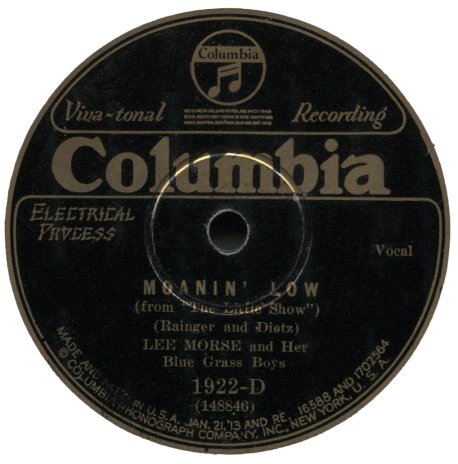
“Moanin’ Low”
Lee Morse And Her Blue Grass Boys
(Columbia 1922 D mx 148846) July 24, 1929
“Sweetness”
Lee Morse And Her Blue Grass Boys
(Columbia 1922 D mx 148847) July 24, 1929
Here are two recordings by blues and jazz singer Lee Morse, one of the top-selling female vocalists for both the Pathe and Columbia labels during the 1920s.
Morse had an utterly unique style. She had a very wide vocal range and, in her recordings, would sometimes break out in whoops and yodels. She does not do that on either of these recordings, but she does begin “Moanin’ Low” with moaning sounds that I suspect raised a few eyebrows in certain quarters.
Morse was born into a musical family that made a living with its own traveling music show. After landing a contract with a West Coast vaudeville circuit, Morse eventually made her way to New York and appeared on Broadway. She began making records for Pathe and its subsidiary Perfect label in 1924 and moved to Columbia in 1927.
In what could have propelled her career to new heights, Morse landed the leading role opposite Ed Wynn in the 1930 Florenz Zigfield production Simple Simon. But what should have been a big break for Lee Morse went instead to Ruth Etting. During the show’s initial trial run in Boston, Morse showed up for the opening performance drunk and couldn’t remember her lines. Ziegfield immediately replaced Morse with Ruth Etting. The show was very successful as was one of its songs, “Ten Cents A Dance,” which became a big hit for Etting.
Despite her Broadway setback, Morse starred in three musical short film features later that year, A Million Me’s, The Music Racket, and Song Service, all of which can be viewed on YouTube. She continued appearing on radio broadcasts and made records for Columbia through 1933.
A throat ailment brought Morse’s career to a halt with the fear that she might not be able to sing again. But after spending time with relatives in Gainsville, Texas, her voice recovered and, accompanied by her husband, pianist Bob Downey, began appearing at various venues in the nearby Fort Worth/Dallas area and on regional radio broadcasts. For awhile, Morse and Downey had a house on the shore opposite of Casino Beach on Lake Worth just outside of Fort Worth.
Multiple online sources, including the Wikipedia article I linked to for her biographical information, claim that, in Texas, she and Downey operated a small club that burned in 1939. In my own research on Morse’s time in Texas, I have yet to find the name of such a club or any mention of Morse and Downey operating such a club.
Morse did appear regularly in 1934 -1935 at the Sylvan Club, located in what is now Arlington, Texas. That club was destroyed by an early morning fire on July 12, 1935. Also destroyed in a dressing room on the club’s second floor where the fire began were 12 expensive gowns and bracelets that belonged to Morse. Neither Morse nor Downey had any ownership interest in the club. I strongly suspect that this is the club and fire that the various articles incorrectly refer to.
Morse recorded a handful of sides for the Decca label in 1938. She moved to Rochester, New York in 1939. In the early 1950s, she attempted a come-back through local Rochester radio broadcasts and a handful of sides she recorded in 1950 that were issued on the Decca and Coral labels. But her come-back had only been locally successful by the time she died in 1954.
Morse’s “Blue Grass Boys” was the pseudonym given to a Columbia in-house ensemble. Its roster varied by recording session but usually featured some of the top New York jazz talent. Both recordings here feature Tommy and Jimmy Dorsey as well as Phil Napoleon and Frank Signorelli.
The song “Moanin’ Low” was introduced by Libby Holman in the 1929 musical revue The Little Show.
